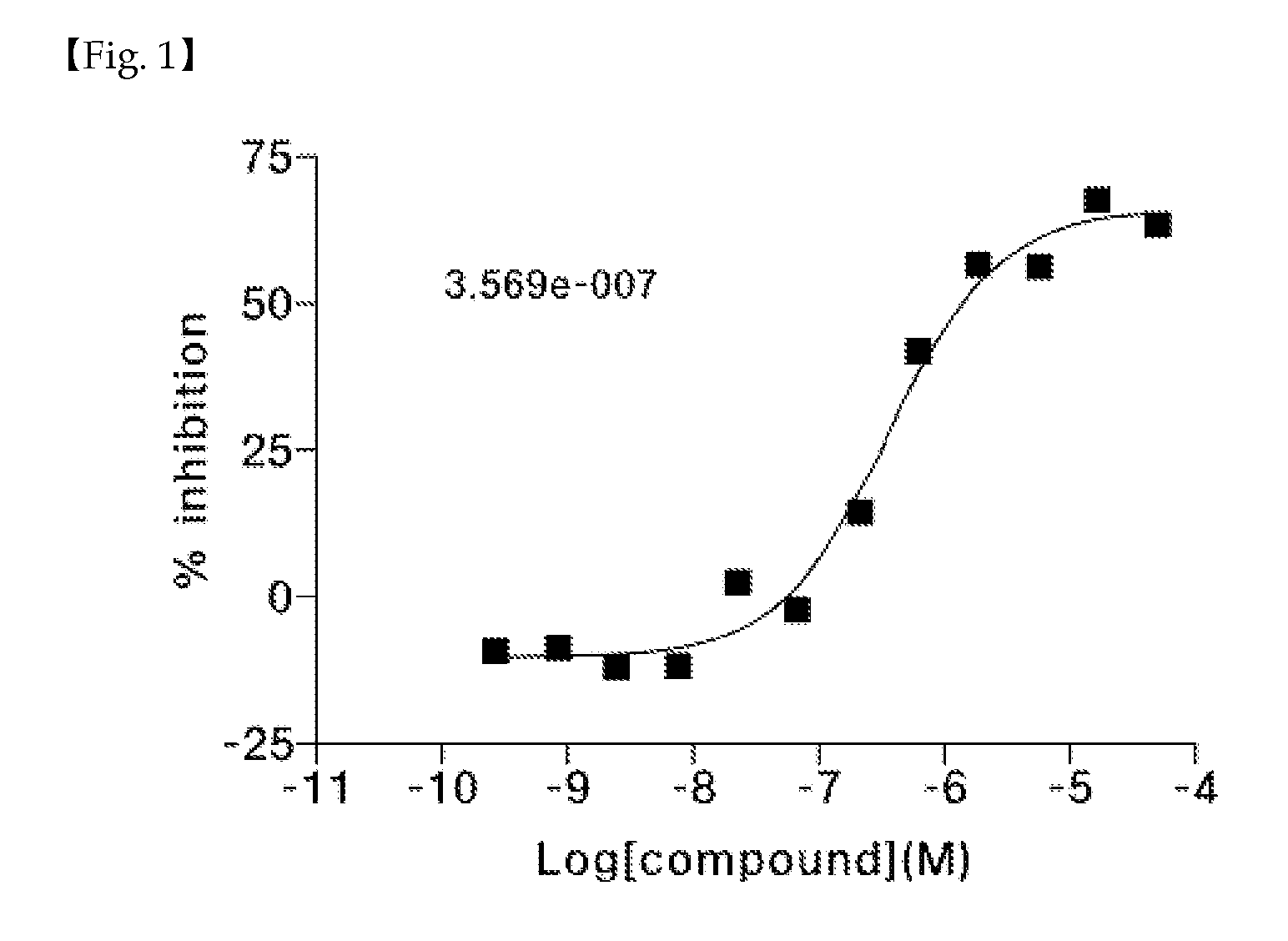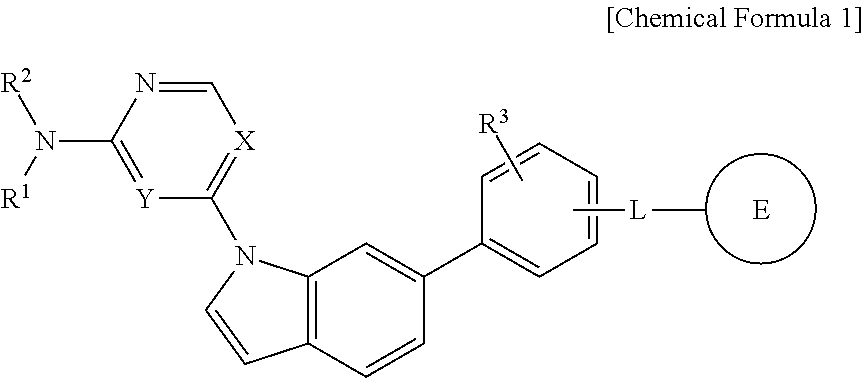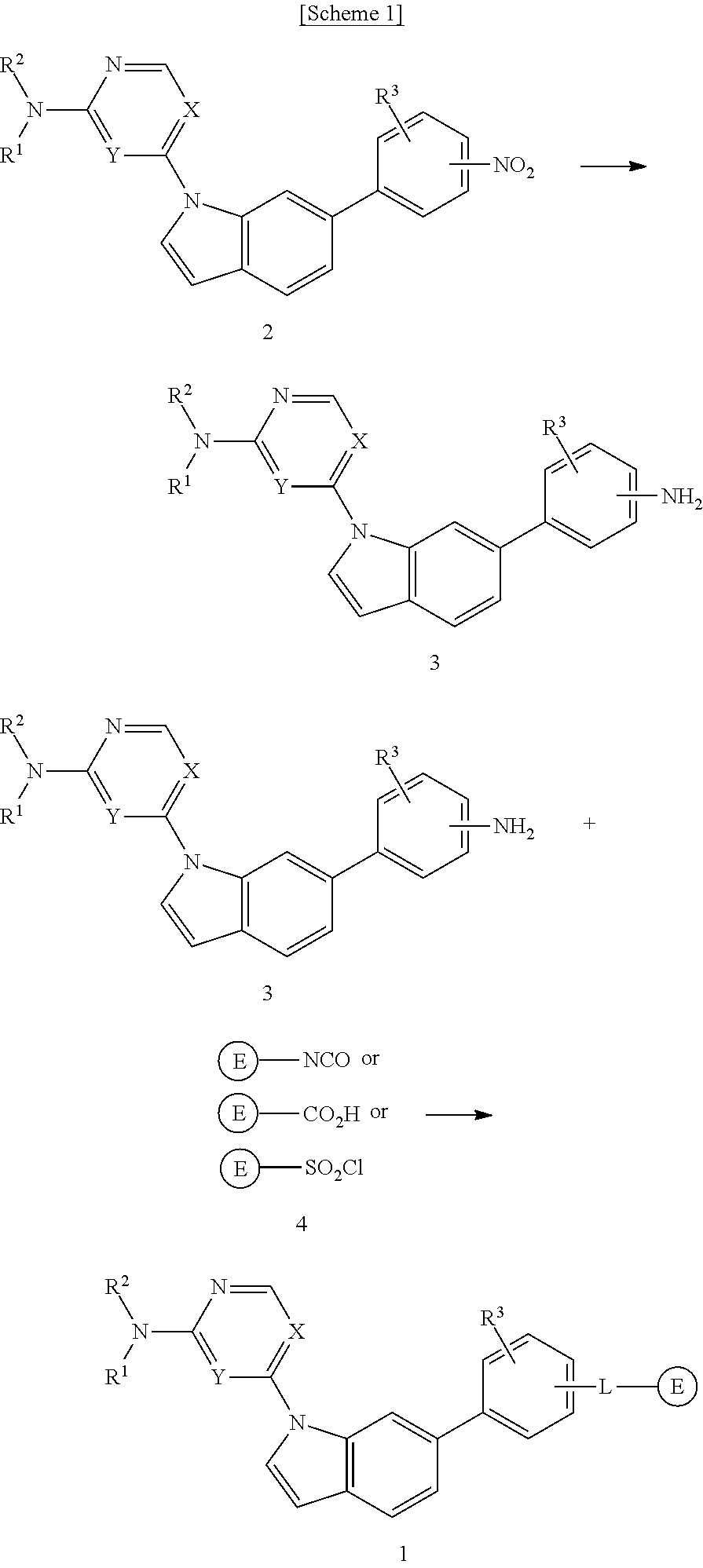Novel 1,6-disubstituted indole compounds as protein kinase inhibitors
a technology of indole compound and protein kinase, which is applied in the direction of heterocyclic compound active ingredients, drug compositions, organic chemistry, etc., can solve the problems of grade 3 skin toxicity, relatively infrequent occurrence of mutations other than v600e, and the signal transduction system in normal cells, and achieve the effect of superior ability to inhibit activity
- Summary
- Abstract
- Description
- Claims
- Application Information
AI Technical Summary
Benefits of technology
Problems solved by technology
Method used
Image
Examples
example 1
1-(3-(1-(6-aminopyrimidin-4-)-1H-indol-6-yl)phenyl)-3-(2-methoxyphenyl)urea
[0110]
Step 1: 6-(3-nitrophenyl)-1H-indole
[0111]
[0112]6-Bromo-1H-indole (1.00 g, 5.10 mmol) and potassium carbonate (1.41 g, 10.2 mmol) were dissolved in a DMF / water (4:1, 10 mL) mixture solution, and then the gas included in the mixture solution was removed using ultrasonic wave and nitrogen gas. After sequentially adding 3-nitrophenylboronic acid (853 mg, 5.61 mmol) and Pd(dppf)Cl2 (416 mg, 0.51 mmol), the mixture was stirred at room temperature in a sealed reactor. 2 hours later, after adding ethyl acetate and water, the reaction solution was filtered through a diatomite pad. The organic layer was separated from the filtrate and the aqueous layer was extracted with ethyl acetate. The combined organic layer was dried with anhydrous magnesium sulfate and then concentrated. Purification of the residue by chromatography (silica gel, EA:Hx=1:4) yielded the target compound as white solid.
[0113]MS m / z [M+1] 239.18...
example 2
1-(3-(1-(6-aminopyrimidin-4-yl)-1H-indol-6-yl)phenyl)-3-(3-chloro-4-(trifluoromethyl)phenyl)urea
[0126]
[0127]The target compound was prepared in the same manner as Example 1 using an appropriate starting material.
[0128]MS m / z [M+1] 522.98; 1H NMR (400 MHz, DMSO-d6) d 9.24 (s, 1H), 9.01 (s, 1H), 8.58 (s, 1H), 8.43 (s, 1H), 8.12 (s, 1H), 7.95 (d, 1H), 7.77 (s, 1H), 7.72 (d, 1H), 7.65 (d, 1H), 7.60 (d, 1H), 7.47 (t, 1H), 7.44 (d, 1H), 7.41 (d, 1H), 7.34 (d, 1H), 7.15 (s, 2H), 6.80 (d, 1H), 6.70 (s, 1H).
example 3
1-(3-(1-(6-aminopyrimidin-4-yl)-1H-indol-6-yl)phenyl)-3-(2-fluorophenyl)urea
[0129]
[0130]The target compound was prepared in the same manner as Example 1 using an appropriate starting material.
[0131]MS m / z [M+1] 439.05; 1H NMR (400 MHz, DMSO-d6) d 9.26 (s, 1H), 8.61 (s, 1H), 8.56 (s, 1H), 8.41 (s, 1H), 8.16 (t, 1H), 7.95 (d, 1H), 7.74 (s, 1H), 7.72 (d, 1H), 7.45 (d, 1H), 7.42 (d, 1H), 7.38 (d, 1H), 7.30 (d, 1H), 7.24 (t, 1H), 7.14 (t, 1H), 7.06 (s, 2H), 7.04 (d, 1H), 6.79 (d, 1H), 6.69 (s, 1H).
PUM
| Property | Measurement | Unit |
|---|---|---|
| Inhibition | aaaaa | aaaaa |
Abstract
Description
Claims
Application Information
 Login to View More
Login to View More - R&D
- Intellectual Property
- Life Sciences
- Materials
- Tech Scout
- Unparalleled Data Quality
- Higher Quality Content
- 60% Fewer Hallucinations
Browse by: Latest US Patents, China's latest patents, Technical Efficacy Thesaurus, Application Domain, Technology Topic, Popular Technical Reports.
© 2025 PatSnap. All rights reserved.Legal|Privacy policy|Modern Slavery Act Transparency Statement|Sitemap|About US| Contact US: help@patsnap.com



